Constructability Analyses of Vertical Extension Methods for Existing Underground Spaces
Abstract
1. Introduction
2. Research Methodology
- (1)
- Bottom-up method: all of the excavation of soil under an existing structure should be completed before vertical underground space extension is performed.
- (2)
- Normal top-down method after demolition of existing underground structures: prior to the construction of structural frames of each basement floor in the substructure, soil with volume corresponding to height of one basement level should be excavated below the floor under the existing structure. These demolition and construction processes are repeated until reaching the desired number of floors.
- (3)
- Normal top-down method in parallel with the demolition of existing underground structures: the construction of structural frames of each extended floor is carried out while supporting and demolishing existing underground structures and the other processes are the same as those in the normal top-down method after demolition.
- (4)
- Top-down method using double beams in parallel with the demolition of existing underground structures: the construction process of this method is very similar to the top-down method in parallel with demolition, but this method uses double beams to support the existing building and installs structural frames for extended underground structures.
3. Underground Vertical Extension Methods
3.1. Bottom-Up Method
3.2. Normal Top-Down Method after Demolition
3.3. Normal Top-Down Method in Parallel with Demolition
3.4. Top-Down Method Using Double Beams in Parallel with Demolition
4. Overview of Illustrative Examples
5. Structural Analysis
5.1. Bottom-Up Method
5.2. Normal Top-Down Method after Demolition
5.3. Normal Top-Down Method in Parallel with Demolition
5.4. Top-Down Method Using Double-Beam Systems
6. Results and Analysis
6.1. Scheduling Perspective
6.2. Cost Perspective
7. Discussion and Conclusions
Author Contributions
Funding
Institutional Review Board Statement
Informed Consent Statement
Data Availability Statement
Conflicts of Interest
Abbreviations
| 1F | First floor |
| B1F to B5F | Basement first floor to basement fifth floor |
| BF | Basement floor |
| C | Column |
| CIP | Cast in place |
| G | Girder |
| KRW | Korean Won |
| PPS | Public Procurement Service |
| PRDs | Percussion rotary drills |
| RC | Reinforced concrete |
| ST | Strut |
| USD | United States Dollar |
| VAT | Value-added tax |
References
- Furlan, R.; AL-Mohannadi, A. An Urban Regeneration Planning Scheme for the Souq Waqif Heritage Site of Doha. Sustainability 2020, 12, 7927. [Google Scholar] [CrossRef]
- Jung, S.J.; Kim, S.-K.; Seo, S.Y. Structural safety of the building constructed by top-down method corresponding to earth pressure distribution and floor system. J. Archit. Inst. Korea 2017, 33, 3–10. [Google Scholar]
- Volchko, Y.; Norrman, J.; Ericsson, L.O.; Nilsson, K.L.; Markstedt, A.; Öberg, M.; Mossmark, F.; Bobylev, N.; Tengborg, P. Subsurface planning: Towards a common understanding of the subsurface as a multifunctional resource. Land Use Policy 2020, 90, 104316. [Google Scholar] [CrossRef]
- Bobylev, N. Underground space as an urban indicator: Measuring use of sub- surface. Tunn. Undergr. Space Technol. 2016, 55, 40–51. [Google Scholar] [CrossRef]
- Bobylev, N. Comparative analysis of environmental impacts of selected underground construction technologies using analytic network process. Autom. Constr. 2011, 20, 1030–1040. [Google Scholar] [CrossRef]
- Kim, U.; Min, B.; Kang, M.; Kim, D.; Choi, H. Behavior Case Study of Temporary Structures during Underground Extension Work by Field Measurement. J. Korean Geo-Environ. Soc. 2020, 21, 5–13. [Google Scholar]
- Bobylev, N. Mainstreaming sustainable development into a city’s Master plan: A case of urban underground space use. Land Use Policy 2009, 26, 1128–1134. [Google Scholar] [CrossRef]
- Kim, K.M.; Rhim, H.C.; Lee, K.J. Development of underground space underneath existing buildings. In Proceeding of the 2010 Conference of Architectural Institute of Korea, Cheongju, Korea, 23 October 2010; pp. 153–154. [Google Scholar]
- Bing, C. Floating underground extension method—Remodeling case 2. Remodeling 2012, 46, 13–20. [Google Scholar]
- Jang, D.; Park, D.; Kim, Y.; Lim, H. Research on the development of FUSEM method for Seoul City main hall. In Proceedings of the Conference of Architectural Institute of Korea, Gwangju, Korea, 25 October 2012; pp. 513–514. [Google Scholar]
- Lee, J.; Bing, C. Remodeling case—Chungdam Chunggu Apartment. Build. Constr. 2012, 12, 42–51. [Google Scholar]
- Park, D.-S.; Lew, Y.-K.; Choi, K.; Lee, J. Introduction of floating underground space extension method (FUSEM) for preservation and continuous utilization of old Seoul city hall. Mag. Korea Concr. Inst. 2013, 25, 44–48. [Google Scholar]
- Kim, S.K.; Lee, J.E.; Kim, T.W.; Koo, J.M.; Jung, S.; Seo, S.Y. Construction technology and structural safety assessment for expansion of underground parking lot of apartment complex. In Proceedings of the 2016 Conference of Architectural Institute of Korea, Busan, Korea, 4–6 October 2016; pp. 1471–1472. [Google Scholar]
- Jung, S.J.; Kim, J.H.; Lee, B.H.; Hwang, K.S.; Seo, S.Y. Establishment of a technology for earthwork safety at new construction/extension of underground parking lot in building. In Proceedings of the 2018 Conference of Korea Concrete Institute, Changwon, Korea, 1 May 2018; pp. 797–798. [Google Scholar]
- Seo, S.y.; Lee, B.; Won, J. Comparative analysis of economic impacts of vertical extension methods for underground spaces of existing buildings. Sustainability 2020, 12, 975. [Google Scholar] [CrossRef]
- Ha, T.; Lee, S. Advanced construction stage analysis of high-rise building considering creep and shrinkage of concrete. In Proceedings of the 2013 World Congress on Advances in Structural Engineering and Mechanics (ASEM13), Jeju, Korea, 8–12 September 2013; pp. 2139–2147. [Google Scholar]
- Lee, D.; Kim, D.; Kang, P. Stories of Strong and Beautiful Building Construction (6); Baro Construction Key-Technology: Seoul, Korea, 2012. [Google Scholar]
- Thompson, J.; Zadoorian, C. A case study for top-down and construction methodology for a high-rise development in Los Angeles, California. In Proceedings of the SEAOC Convention Proceedings, Big Island, HI, USA, 23–27 September 2008; pp. 1–8. [Google Scholar]
- Ro, Y.-C.; Lee, C.-S. Selection of retaining wall system for underground parking lots expansion of apartments. J. Korea Inst. Constr. Eng. Manag. 2008, 9, 99–107. [Google Scholar]
- Archidata Design. Eart Retaining Wall. Available online: http://www.archidata.co.kr/NewWin/NewWin.asp?VT=Design&selID=54599&ddcodeid=2291 (accessed on 9 January 2020).
- Seo, S.; Lee, R.; Construction, S.H. Permanent earth retaining composite frames for constructing underground structure. In Proceedings of the Conference of Architecutal Institute of Korea, Jecheon, Korea, 24–25 October 2005; pp. 41–68. [Google Scholar]
- Lee, D.; Kim, D.; Kang, P. Sturdy and Beautiful Architecture Construction Story 5—Top-Down Method; Baro Construction Technology: Seoul, Korea, 2013. [Google Scholar]

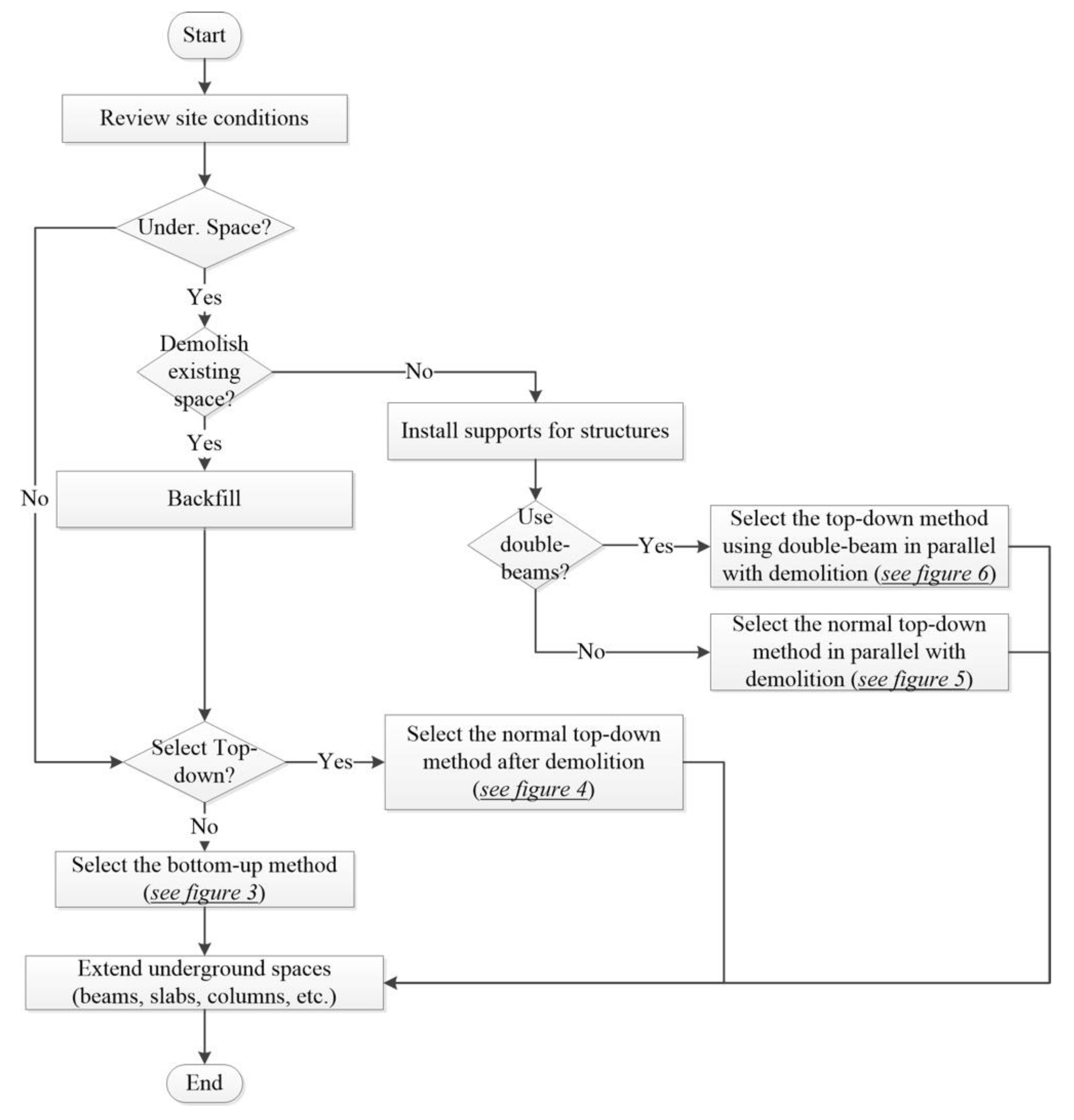
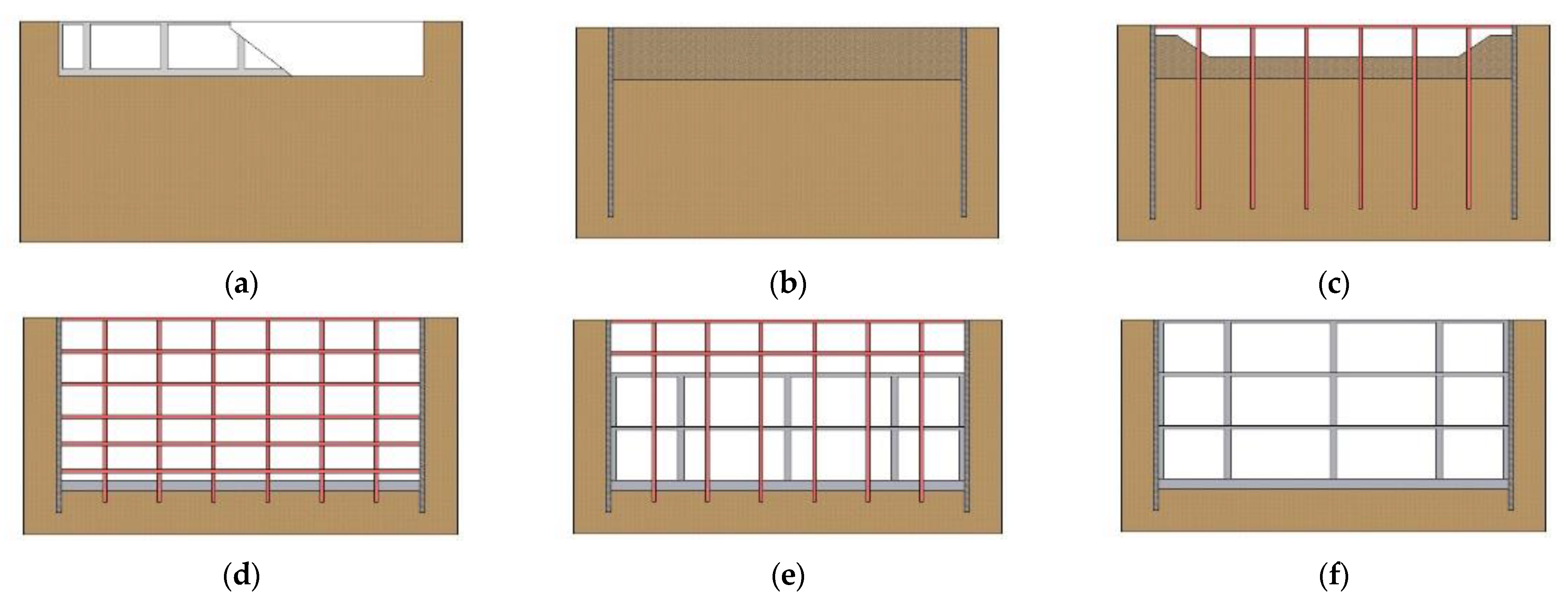
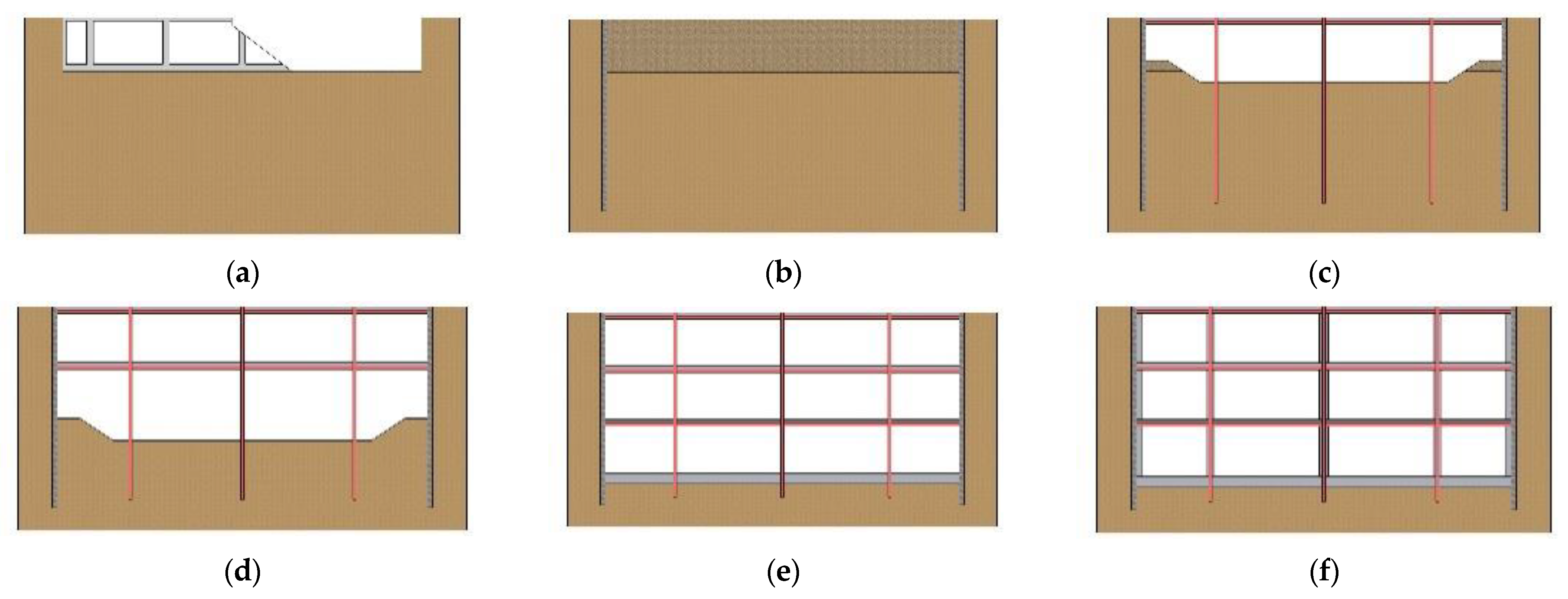
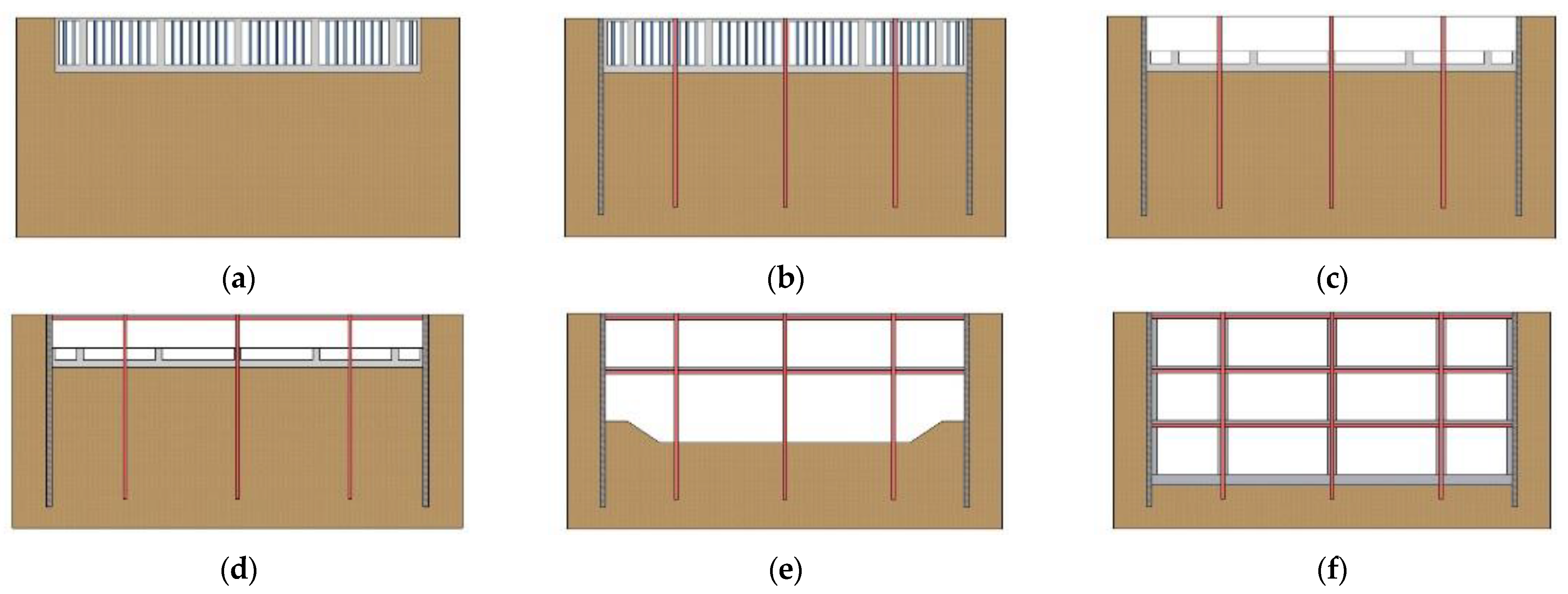
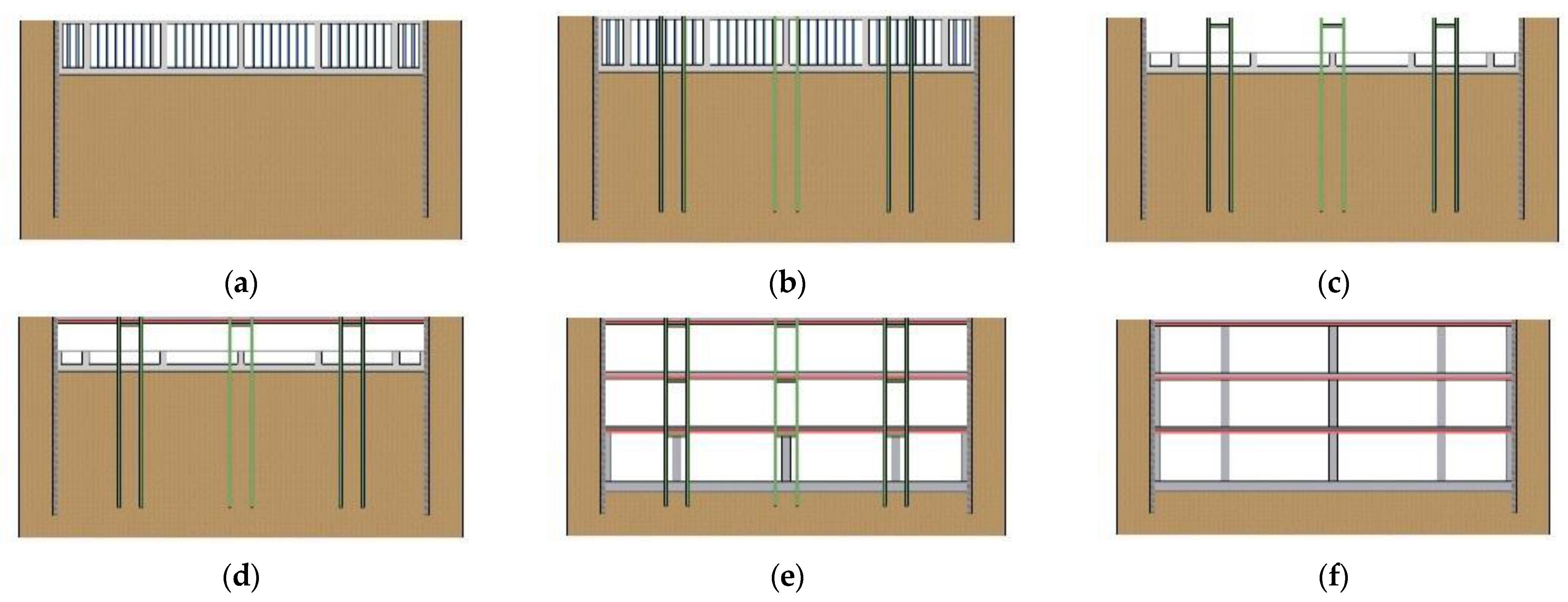

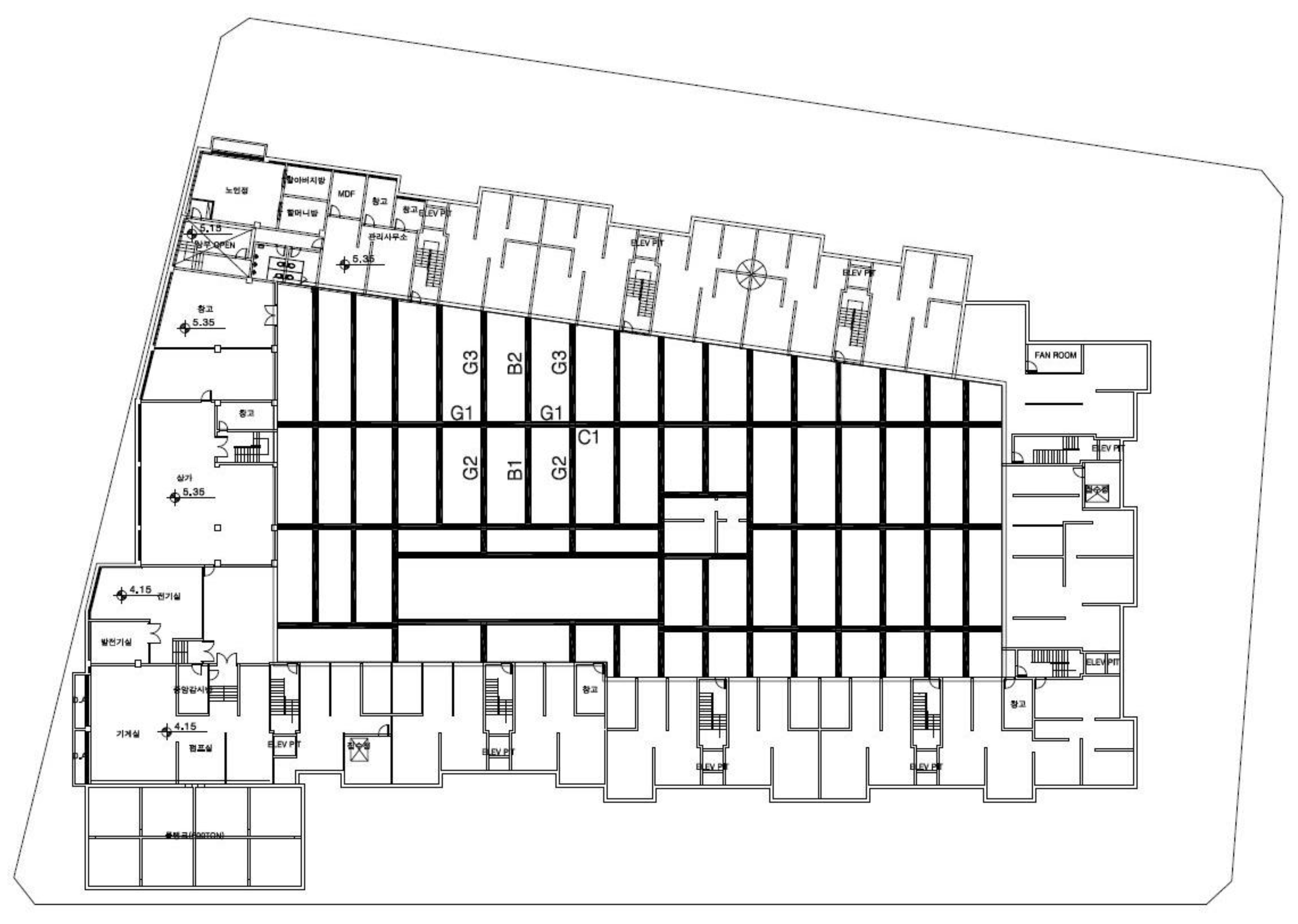


| Floor | Size of Parking Lot Modules | Number of Parking Spaces | |||
|---|---|---|---|---|---|
| Floor | Total | Increase Rate | |||
| Existing underground space | B1F | 5.5 × 5.2 m | 75 | 75 | - |
| Remodeled underground space | B3F | 7.8 × 9.0 m | 59 | 177 | 136% |
| B4F | 7.8 × 9.0 m | 59 | 236 | 215% | |
| B5F | 7.8 × 9.0 m | 59 | 295 | 293% | |
| No. | Number of Extended Basement Floors | Vertical Underground Extension Method | Structural Type |
|---|---|---|---|
| 1 | 3 | Bottom-up | RC |
| 2 | 3 | Top-down after demolition | Steel |
| 3 | 3 | Top-down in parallel with demolition | Steel |
| 4 | 3 | Top-down using double-beam system | Steel |
| 5 | 4 | Bottom-up | RC |
| 6 | 4 | Top-down after demolition | Steel |
| 7 | 4 | Top-down in parallel with demolition | Steel |
| 8 | 4 | Top-down using double-beam system | Steel |
| 9 | 5 | Bottom-up | RC |
| 10 | 5 | Top-down after demolition | Steel |
| 11 | 5 | Top-down in parallel with demolition | Steel |
| 12 | 5 | Top-down using double-beam system | Steel |
| Member | Size | Type | Force Ratio of Acting Stress to Holding Strength | |
|---|---|---|---|---|
| Girder | G1 first floor (1F) | 700 × 900 | Moment | 0.908 |
| Shear force | 0.992 | |||
| G2 (1F) | Moment | 0.781 | ||
| Shear force | 0.566 | |||
| G3 (1F) | Moment | 0.700 | ||
| Shear force | 0.961 | |||
| G1 basement floor (BF) | 600 × 700 | Moment | 0.921 | |
| Shear force | 0.928 | |||
| G2 (BF) | Moment | 0.551 | ||
| Shear force | 0.480 | |||
| G3 (BF) | Moment | 0.781 | ||
| Shear force | 0.637 | |||
| Column | C1 (B3F) | 600 × 600 | Axial force | 0.888 |
| C1 (B4F) | 700 × 700 | Axial force | 0.888 | |
| C1 (B5F) | Axial force | 0.987 | ||
| Strut | ST1 | H-300 × 300 × 10 × 15 | Axial force | 0.172 |
| ST2 | H-300 × 300 × 10 × 15 | Axial force | 0.212 | |
| ST3 | H-300 × 300 × 10 × 15 | Axial force | 0.245 | |
| ST4 | H-300 × 300 × 10 × 15 | Axial force | 0.307 | |
| ST5 | H-300 × 300 × 10 × 15 | Axial force | 0.411 | |
| ST6 | H-300 × 300 × 10 × 15 | Axial force | 0.560 | |
| ST7 | H-300 × 300 × 10 × 15 | Axial force | 0.773 | |
| Member | Size | Force Ratio of Acting Stress to Holding Strength | |||
|---|---|---|---|---|---|
| 1F | BF | 1F | BF | ||
| Girder | G1 | H-588 × 300 × 12 × 20 | H-500 × 200 × 10 × 16 | 0.792 | 0.810 |
| G2 | H-600 × 200 × 11 × 17 | H-466 × 199 × 8 × 12 | 0.760 | 0.726 | |
| G3 | H-588 × 300 × 12 × 20 | H-500 × 200 × 10 × 16 | 0.860 | 0.867 | |
| Column | C1(B3F) | 700 × 700 (H-400 × 400 (B3F), H-414 × 405 (B4F-5F)) | 0.266 | ||
| C2(B4F) | 0.267 | ||||
| C3(B5F) | 0.357 | ||||
| Member | Size | Force Ratio of Acting Stress to Holding Strength | |
|---|---|---|---|
| Girder | G1 | H-500 × 200 × 10 × 16 | 0.792 |
| G2 | H-350 × 175 × 7 × 11 | 0.760 | |
| Column | C1(B3F) | 600 × 600 | 0.792 |
| C2(B4F) | 0.910 | ||
| C3(B5F) | 650 × 650 | 0.965 | |
| Work Type | Calculated Construction Duration (Unit: Day) | |||
|---|---|---|---|---|
| Preparation | 20 | |||
| Support installation | 20 | |||
| Demolition and backfill | 40 | |||
| Retaining wall | Equipment preparation | 2 | ||
| Cast in place (CIP) installation | = # of CIPs/average daily workload= 419/10 = 41.9 | |||
| Application of equipment | 2 | |||
| Subtotal | 45.9 | |||
| Pile | Pile installation | = # of piles/average daily workload= 72/10 = 7.2 | ||
| PRD | Out casing | 3 | ||
| Equipment preparation | 3 | |||
| PRD installation | = # of PRDs/average daily workload= 25/1.1 = 22.7 | |||
| Application of equipment | 2 | |||
| Subtotal | 30.7 | |||
| Temporary post work | 13 | |||
| Foundation | 30 | |||
| Structural frame construction | 90 | |||
| Finish | 45 | |||
| Inspection | 60 | |||
| Miscellaneous | 30 | |||
| Extended floors of underground spaces | ||||
| B3F | B4F | B5F | ||
| Strut and excavation | Strut | = # of strut layers ×20 (days) | ||
| = 4 × 20 = 80 | = 5 × 20 = 100 | = 7 × 20 = 140 | ||
| Excavation | = Area of floors excavated in underground spaces × height of excavated underground spaces/(daily excavation workload × coefficient of construction (1.0)) | |||
| = (1886.1 × 10.5)/(300 × 1.0) = 66.0 | = (1886.1 × 14.0)/(300 × 1.0) = 88.0 | = (1886.1 × 17.5)/(300 × 1.0) = 110.0 | ||
| Subtotal | 80 | 100 | 140 | |
| Top-down and excavation | Top-down | = # of floors of extended underground spaces × 25 (days) | ||
| = 3 × 25 = 75 | = 4 × 25 = 100 | = 5 × 25 = 125 | ||
| Excavation | = Area of floors excavated in underground spaces × height of excavated underground spaces/(daily excavation workload × coefficient of construction (0.9)) | |||
| = (1886.1 × 10.5)/(300 × 0.9) = 66.0 | = (1886.1 × 14.0)/(300 × 0.9) = 88.0 | = (1886.1 × 17.5)/(300 × 0.9) = 110.0 | ||
| Subtotal | 75 | 100 | 125 | |
| Work Type | To B3F | To B4F | To B5F | |||||||||
|---|---|---|---|---|---|---|---|---|---|---|---|---|
| Extension Method | Extension Method | Extension Method | ||||||||||
| (A) | (B) | (C) | (D) | (A) | (B) | (C) | (D) | (A) | (B) | (C) | (D) | |
| Preparation | 20 | 20 | 20 | 20 | 20 | 20 | 20 | 20 | 20 | 20 | 20 | 20 |
| Support installation | 20 | 20 | 20 | 20 | 20 | 20 | ||||||
| Demolition and backfill | 40 | 40 | 40 | 40 | 40 | 40 | ||||||
| Retaining wall | 42 | 42 | 42 | 42 | 42 | 42 | 42 | 42 | 42 | 42 | 42 | 42 |
| Pile | 7 | 7 | 7 | |||||||||
| PRD | 31 | 31 | 31 | 31 | 31 | 31 | ||||||
| Temporary post work | 13 | 13 | 13 | |||||||||
| Strut and excavation | 80 | 100 | 140 | |||||||||
| Top-down and excavation | 75 | 75 | 75 | 100 | 100 | 100 | 125 | 125 | 125 | |||
| Foundation | 30 | 30 | 30 | 30 | 30 | 30 | 30 | 30 | 30 | 30 | 30 | 30 |
| Structural frame construction | 90 | 120 | 150 | |||||||||
| Finishing | 45 | 45 | 45 | 60 | 60 | 60 | 75 | 75 | 75 | |||
| Inspection | 60 | 60 | 60 | 60 | 80 | 80 | 80 | 80 | 100 | 100 | 100 | 100 |
| Miscellaneous | 30 | 30 | 30 | 30 | 30 | 30 | 30 | 30 | 30 | 30 | 30 | 30 |
| Total construction duration | 289 | 263 | 243 | 225 | 339 | 303 | 283 | 265 | 409 | 343 | 323 | 305 |
| Difference | - | (26) | (46) | (64) | - | (36) | (56) | (74) | - | (66) | (86) | (104) |
| Decrease rate | - | 9.0% | 15.9% | 22.1% | - | 10.6% | 16.5% | 21.8% | - | 16.1% | 21.0% | 25.4% |
| No. | Classification | Ratio |
|---|---|---|
| 1 | Material cost | Quantities and itemized unit costs |
| 2 | Direct labor cost | Quantities and itemized unit costs |
| 3 | Indirect labor cost | (2) × 7.30% |
| 4 | Subtotal | (2 + 3) |
| 5 | Overhead cost | Statement |
| 6 | Accident and employment insurance | (4) × 3.75% |
| 7 | Health insurance | (2) × 3.23% |
| 8 | Long-term care insurance | (7) × 8.51% |
| 9 | Annuity insurance and retirement deduction | (2) × 6.80% |
| 10 | Safety management expense | (1 + 2) × 5.50% |
| 11 | Expense for environmental conservation | (1 + 2 + 5) × 0.05% |
| 12 | Other expense | (1 + 4) × 7.8% |
| 13 | Subtotal | (6 + 7 + 8 + 9 + 10 + 11 + 12) |
| 14 | General administrative expense | (1 + 4 + 5 + 13) × 5.5% |
| 15 | Profit | (4 + 5 + 13 + 14) × 12% |
| 16 | Net construction cost | (1 + 4 + 5 + 13 + 14 + 15) |
| 17 | VAT | (16) × 10% |
| 18 | Total construction cost | (16 + 17) |
| Work Type | To B3F | To B4F | To B5F | ||||||||||
|---|---|---|---|---|---|---|---|---|---|---|---|---|---|
| Extension Method | Extension Method | Extension Method | |||||||||||
| (A) | (B) | (C) | (D) | (A) | (B) | (C) | (D) | (A) | (B) | (C) | (D) | ||
| Support installation | - | - | 172 | 172 | - | - | 172 | 172 | - | - | 172 | 172 | |
| Demolition | 505 | 505 | 505 | 505 | 505 | 505 | 505 | 505 | 505 | 505 | 505 | 505 | |
| Backfill | 53 | 53 | - | - | 53 | 53 | - | - | 53 | 53 | - | - | |
| Retaining wall | 2013 | 2013 | 2013 | 2013 | 2704 | 2704 | 2704 | 2704 | 3349 | 3349 | 3349 | 3349 | |
| Pile | 1104 | 730 | 730 | 730 | 1480 | 978 | 978 | 978 | 1856 | 1227 | 1227 | 1227 | |
| PRD | - | 180 | 180 | - | - | 240 | 240 | - | - | 299 | 299 | - | |
| Temporary post | - | - | - | 275 | - | - | - | 387 | - | - | - | 479 | |
| Strut | 290 | - | - | - | 363 | - | - | - | 508 | - | - | - | |
| Excavation | 2912 | 2912 | 2912 | 2912 | 4044 | 4044 | 4044 | 4044 | 5176 | 5176 | 5176 | 5176 | |
| Top-down (steel) | - | 588 | 588 | 355 | - | 751 | 751 | 457 | - | 913 | 913 | 559 | |
| Structural frame construction | 2681 | 1776 | 1776 | 1764 | 3438 | 2271 | 2271 | 2255 | 4195 | 2766 | 2766 | 2746 | |
| Total cost | 9558 | 8757 | 8877 | 8726 | 12,587 | 11,545 | 11,665 | 11,502 | 15,642 | 14,288 | 14,408 | 14,213 | |
| Difference | - | (801) | (682) | (832) | - | (1042) | (922) | (1085) | - | (1354) | (1235) | (1429) | |
| Decrease rate | - | 8.4% | 7.1% | 8.7% | - | 8.3% | 7.3% | 8.6% | - | 8.7% | 7.9% | 9.1% | |
Publisher’s Note: MDPI stays neutral with regard to jurisdictional claims in published maps and institutional affiliations. |
© 2021 by the authors. Licensee MDPI, Basel, Switzerland. This article is an open access article distributed under the terms and conditions of the Creative Commons Attribution (CC BY) license (http://creativecommons.org/licenses/by/4.0/).
Share and Cite
Seo, S.-Y.; Lee, B.; Won, J. Constructability Analyses of Vertical Extension Methods for Existing Underground Spaces. Sustainability 2021, 13, 3647. https://doi.org/10.3390/su13073647
Seo S-Y, Lee B, Won J. Constructability Analyses of Vertical Extension Methods for Existing Underground Spaces. Sustainability. 2021; 13(7):3647. https://doi.org/10.3390/su13073647
Chicago/Turabian StyleSeo, Soo-Yeon, Byunghee Lee, and Jongsung Won. 2021. "Constructability Analyses of Vertical Extension Methods for Existing Underground Spaces" Sustainability 13, no. 7: 3647. https://doi.org/10.3390/su13073647
APA StyleSeo, S.-Y., Lee, B., & Won, J. (2021). Constructability Analyses of Vertical Extension Methods for Existing Underground Spaces. Sustainability, 13(7), 3647. https://doi.org/10.3390/su13073647







